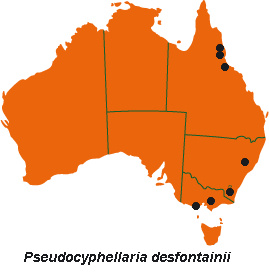



Australian Biological Resources Study
| Checklist of the Lichens of Australia and its Island Territories | ||
| Introduction | A–D | E–O | P–R | S–Z | Oceanic Islands | References | ||
| Pseudocyphellaria desfontainii (Delise) Vain. | ||
| Résult. Voy. Belgica, Lich. 29 (1903); Sticta desfontainii Delise, Mém. Soc. Linn. Calvados 2: 60, pl. 4, fig. 12 ('1822') [1825]. T: Île de Bourbon [Réunion], J.B.G.G.M.Bory de St-Vincent; lecto: PC-THURET, fide D.J.Galloway & P.W.James, Nova Hedwigia 42: 434 (1986); isolecto: PC-LENORMAND. | ||
| Thallus rosette-forming to irregularly spreading, closely attached centrally, 4–8 (–10) cm wide; margins ±free. Lobes subdichotomously branching to complex-imbricate, 0.5–3 (–6) cm long, 2–8 (–15) mm wide; lobe margins entire (at apices) to indented, ragged or crenulate, slightly thickened and ridged below, sparsely to densely isidiate. Upper surface pale grey or bluish to red-brown when dry, blue-black to glaucous blue when wet, undulate, shallowly pitted to deeply faveolate, maculate and isidiate, without soredia, phyllidia or pseudocyphellae. Isidia solitary to crowded, terete, simple, rarely squamiform or coralloid, 0.5–1.5 mm tall, 0.1–0.2 mm diam., eroding at apices and appearing pseudosorediate, leaving yellow scars resembling pseudocyphellae. Maculae minute, white or yellowish, effigurate to ±reticulate (×10 lens). Medulla white. Photobiont Nostoc. Lower surface pale yellowish to buff or red-brown, tomentose from margins to centre, or ±glabrous at margins. Pseudocyphellae yellow, scattered, rounded, to 0.2 (–0.5) mm diam., conical-verruciform; decorticate area plane to convex. Apothecia rare, sessile to subpedicellate, at first shallowly to deeply cupuliform, undulate and ±plane at maturity, 0.5–3 mm diam.; disc red-brown to ±black, grey-white-pruinose; exciple prominent, pale whitish pink and ±translucent when wet, brownish or red-brown when dry, coarsely corrugate-scabrid; epithecium red-brown; hymenium very variable in colour. Ascospores ellipsoidal, 1-septate, 23–28 (–30) × 6.5–11 µm, red-brown. CHEMISTRY: Tenuiorin (major), methyl gyrophorate (trace), gyrophoric acid (trace), hopane-6α,7β,22-triol (minor), 7β-acetoxyhopane-22-ol (trace), stictic acid (major), cryptostictic acid (trace), norstictic acid (trace), constictic acid (minor), pulvinic acid, pulvinic dilactone and calycin. |  |
|
| Occurs in eastern Qld, eastern N.S.W., A.C.T. and southern Vic. Rather rare, on living and dead bark and on rocks in well-lit situations in scrub and open forest, to an altitude of 1370 m. Widely distributed in the Palaeotropics from Mauritius, Madagascar and the Indian Ocean islands, south and east Asia and eastwards into the Pacific. | ||
| Galloway et al. (2001) | ||
| Checklist Index |
| Introduction | A–D | E–O | P–R | S–Z | Oceanic Islands | References |
This work is copyright. Apart from any use as permitted under the Copyright Act 1968, no part may be reproduced by any process without prior written permission from Australian Biological Resources Study. Requests and inquiries concerning reproduction and rights should be addressed in the first instance to Dr P. McCarthy. These pages may not be displayed on, or downloaded to, any other server without the express permission of ABRS.